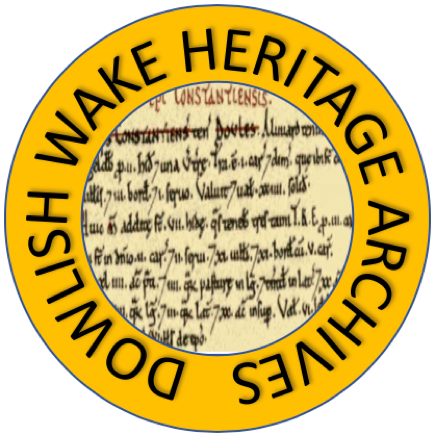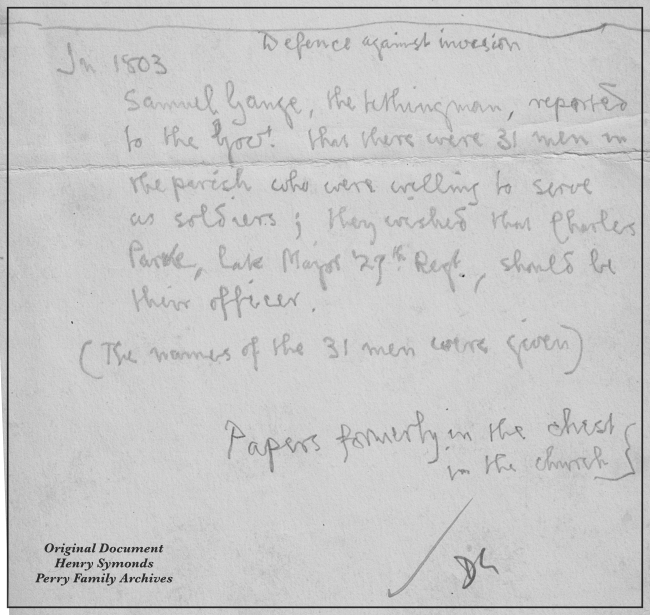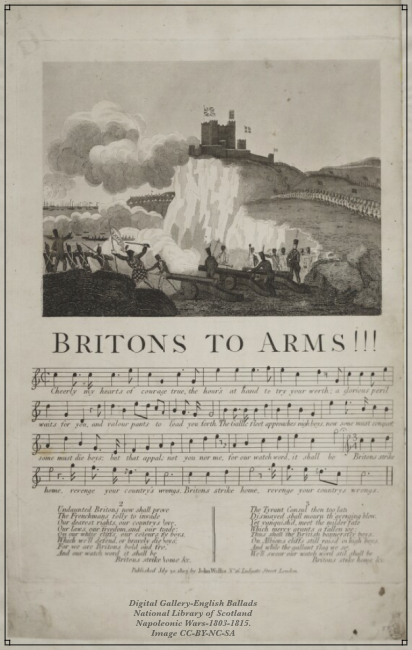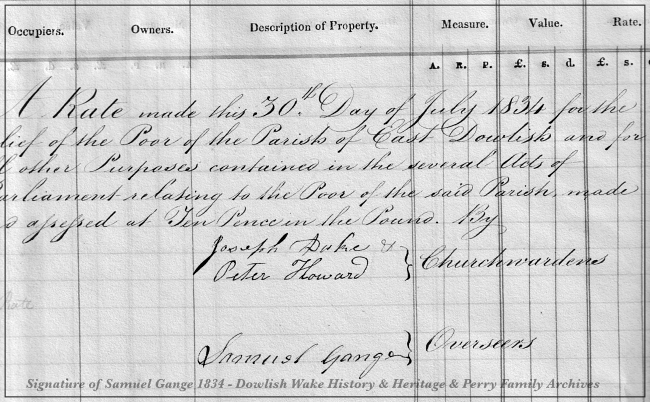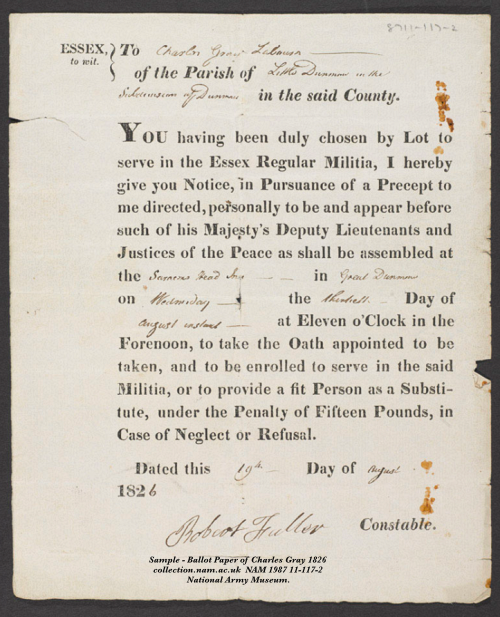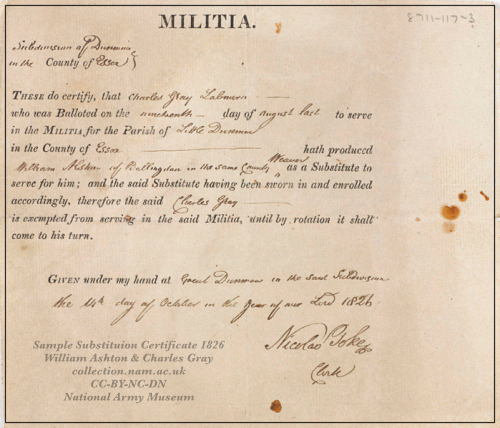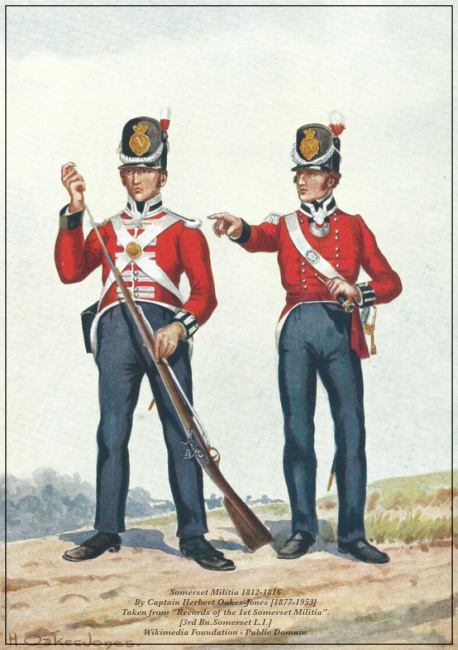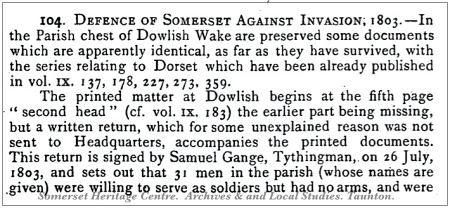- Defence against French Invasion
- Dowlish Men and Napoleon's Army
- The Parish Chest and its Spring-cleaning.
In 1906, historian Henry Symonds, whose forbears held Dowlish Wake Mill, told of documents preserved in Dowlish Wake Parish Chest relating to 1803 and the anticipated invasion of the country by the French. In early July, open-air meetings were held, one at Bridgewater. Those gathered told of a real threat of invasion from Napoleon across the channel.
In May 1803, Britain declared war on France. In June, the House of Commons told of a revision to the Defence of The Realm Act. 50,000 men were required, an 'Army of Reserve'. Numbers raised by ballot, with a four-year term of service. Newspapers reported, 'Local Peasantry keen to repel Napoleon's army, volunteers shouldering Pikes and Muskets'.
Open Air Meetings.
On 5 July at Taunton, the Rt. Hon. Lord Earl Poulett, Lord Lieutenant, addressed his deputy Lieutenants, including Ilminster's. Instructing them to have the returns in their possession by Tuesday, 26 July. Requested details of parish resources, men, animals and food. Printed paper forms to be filled in by every parish nationwide.
“I am ordered to requeft you will have the goodnefs to call your parifhioners together as early as poffible, and uie your warmest and best endeavour to aid and affift the Lord Lieutenant and Deputy Lieutenants in carrying into execution the fchedules and plans adopted for the fafety and defence of the country" [as printed in the local newspaper]
Ilminster’s sub-division Lieutenants, set up office that week in the George Inn, Ilminster. It was ordered each parish officiating clergyman hold a copy letter of the Crown instructions.
Parishioners attending these open-air meetings were told;
‘Repel a haughty and ambitious and powerful enemy, who now openly threatens these united Kingdom’s not only with invasion, but with the destruction of everything dear to Britons’.
Speakers relayed the orders received from the Secretary of War. Men from each parish within its ‘Hundred’ be balloted to serve in the Militia.
Life in our villages stirred by these happenings, the ‘rallying call’ talked of in fields, lanes, towns and markets. Tunes were no doubt whistled and sang, the old marching songs revived.
Popular songs of the day.
The online digital library, 'The National Library of Scotland', has a long list of ballads from 1803. English ballads such as ‘Britannia’s Charge to the Sons of Freedom’ & ‘Britons to Arms’. Penny song sheets with content such as the popular ballad, ‘The Girl I Left Behind’, already having been sung during the Revolutionary Wars.
Cartoons and Printed Dialogue.
These became popular, an eruption of handbills, broadsheets, posters and notes printed, purchased and circulated locally in villages and towns. Titles such as;
Bonaparte’s Handbills, or a Charming Prospect for John Bull and his Family. Price 6d each or 5s a dozen.
John Bull and Bonaparte; a Dialogue. Price 6d a dozen.
The Warning Drum: An ‘addrefs’ to the people to repel invasion.Price 3d each or 2/6 a dozen.
A Dramatic Dialogue between an English Sailor and a Frenchman.Price 6d each or 5s a dozen.
The Christian Observer told of titles such as;
The British Lion is Roused! & The French Tyrant Trembles.
Price: 1d or eight for 6d.
Influence of Handbills.
The Birmingham Post & London Gazette, July 1803, sought to encourage a spirit of patriotism for King and Country. In their editorial, under the headline, Patriotic and Popular Publications, the message:
‘So powerful an engine as the ‘pres’ has been proved to be in influencing the minds of men, we cannot but consider that the country is greatly indebted to those gentlemen in the metropolis who gratuitously distribute to many, excellent handbills and addresses calculated to influence and inspirit the lower classes and the community at this important crisis; and we would earnestly recommend the formation of a committee for the same purpose in every town throughout the kingdom’.
Notice on the Church Door.
The day eventually arrived in Dowlish Wake, Samuel Gange the church-warden posted on the church door, the ballot results, names of the men who had been drawn. The village militia ballot was completed, and some families were more involved than others. However, it had become possible that a man might arrange for a substitute to take his place.
Militia Insurance and Substitutes.
The newspapers of that time showed advertisements for ‘Insurance Policies’ to purchase, allowing men to put forward a substitute in their place. Substitutes had to be of the same Parish and Hundred. Enterprising insurance schemes asked premiums of £2-10d, which would pay out £20 if a man’s lot was drawn. The Sherbourne Militia Insurance Society had an agent in Ilminster with at least two other rival companies. Men whose names were recorded on ballot sheets could either serve or have another serve for them.
A ‘small’ sum of money to avoid anxiety.
Having paid the insurers a subscription, a man would receive a certificate/policy, so be freed from the anxiety of the probability of having their name drawn. In the words of Ilminster’s Crutwell, Son & Co, in April 1802:
Having paid sixteen shillings and having his name drawn, a man could receive ten shillings, or should he prefer, have a substitute provided; indeed, a 'proper person' thus receiving in return for a small sum of money, more than sufficient having risked such a small sum.
April 1802, Crutwells posted an advertisement, telling of the heavy Draft expected that year, this for the different Militia Regiments in the Western Counties. Plus, a new Bill augmenting the Militia Force from thirty thousand to sixty thousand men. Agents such as Crutwells were waiting for business in Ilminster. Agent Mr Hill was ready and on hand to issue certificates.
A rival to Crutwells was a D. M. Keele of Militia Insurance with his Ilminster agent, Mr Clarke. His advertisement notice was dated February 1802. His subscriptions to include a share of the overplus so reducing future subscriptions, a ‘Perpetual Militia Insurance’. This was offered for a sum of thirteen shillings and sixpence. He promoted this as a fair, just, equitable plan.
Dowlish Wake's contribution.
So, Dowlish Wake offered thirty-one men willing to serve as soldiers.
However, no 'arms' were available, and no livestock, vehicles or horses were offered. The parish miller, Edward Symonds, argued lack of water prevented him from engaging in supplying a greater quantity of meal than his usual customers consumed. If there was no scarcity of water, the miller would be able to provide 10 quarters of meal weekly, over and above his usual needs. The return conveyed they were 'desirous' their leader/lieutenant to be Charles Parke. He had been made Lieutenant of the 3rd Regiment of Foot in June.
Dowlish Wake wheelwright Samuel Gange signed and returned the forms dated 26 July 1803.Of the 31 soldiers willing to serve, nothing is known. Hopefully, their names will be revealed when the correct archive location is known.
Organisation of the volunteers.
Locally, there was the 1st and 2nd Somerset Militia, numbers already re-embodied in 1801, having stood down in 1799. When Britain declared war on France in May 1803, numbers increased to 1200 men in 12 companies by June. The extra men were either placed in new units or absorbed into existing units. By late May, the 1st Somerset Militia provided parties to reinstate and man the Fire Beacons on Somerset Hills. Officers from the 1st and the 2nd chose selected groups of sharp sharpshooters for training and deployment. The district Commander, Major General Thomas Grosvenor.
1803 Weymouth
In 1803, some 20,000 Somerset men enrolled in the various Regiments/Volunteer Corps and Yeomanry. Tracking the whereabouts of the Dowlish men during 1803 to 1805 is difficult. The whereabouts of Charles Clarke's 3rd regiment of foot have proved impossible. However, we are told that on 23 August 1803, detachments of Somerset regiments were marched to Weymouth. Here, the 1st and 2ndSomerset’s camped alongside the 1st Staffordshire Militia. Later, they were joined by men from the German Legion.
His Majesty in Weymouth.
King George III had a residence in Weymouth. While the Royal family were in residence, Somerset regiments spent the summer there, as they did in 1804.
Still in Weymouth, early on the morning of 27 September 1804, his Majesty inspected the troops in their usual exercise. The troops then marched away to the sands.
The next day, 28th, his Majesty, on horseback and her Majesty and the Princesses in five carriages proceeded to the parade field in Weymouth. Here, the second Division of the Somerset Militia was assembled. They were reviewed by His Majesty, with Lord Hinton giving the signal. Gathered were a great crowd of onlookers, with the London Evening Mail commenting, 'those assembled were nearly all the beauty and fashion of the place'. 'The troops acquitted themselves with credit and gave great satisfaction to His Majesty and the Staff officers who were present.
The following day saw his Majesty on horseback at seven o'clock to see the troops in ‘this neighbourhood brigaded’. Additionally, the newspaper reported, 'This morning early the Princess Elizabeth bathed.' In the present day, on Weymouth Seafront, there is displayed a full-size replica of King George’s sea bathing machine.
Weymouth was witness to considerable activity during those few days. A ‘grand’ Naval Exhibition, five marquees pitched on the shore with tables for a large company laid. In the evening, the 'Wheel of Fortune' was commanded by their Majesties. Weymouth was bright with nobility, gentry, and the Queen's Band playing. Echoes rebounding in the troop's quarters, no doubt.
The number of infantry and officers in Weymouth, 5000 at times, dwarfed the 1000 population.
Sadly, the previous week, at a display of fireworks, one of Earl Poulett's servants had died, having been accidentally hit when a hamper of rockets exploded.
1805 Marching through the South-West.
Marching songs accompanied the lines of men of the Somerset Militia as they moved around the south-west, marching on-route to various camps. Gosport, Winchester, Poole and Southampton. On Tuesday, 1 July 1805, the 2nd Somerset Militia were at Portsmouth Garrison before moving to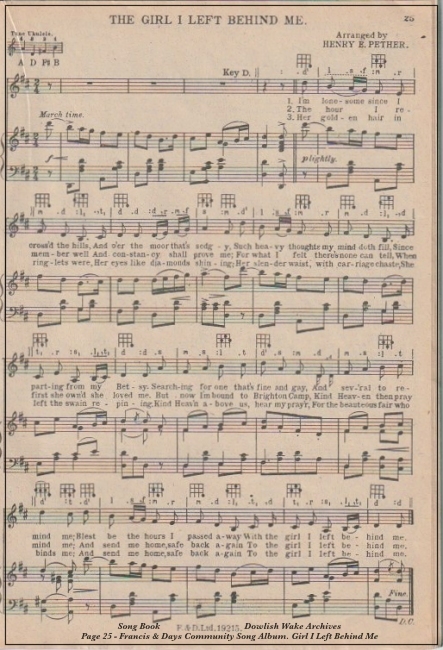
In June of 1805, the Summer Encampment at Weymouth was filling up, began on the 4th of July, expected to be completed by the 15th. Some 7613 men in all.
One troop of Horse Artillery – British, 135
One troop of Heavy Horse Artillery, 164
1st Light Dragoons, 817
Kings German Legion, 591
21st Foot, 650
31st Foot, 945
35th Foot, 573
1st Somerset, 888
2nd Somerset, 850
The regiments remained until October, then spent the winter at Gosport Barracks before returning to Weymouth until October 1805. From there, in November, the second Somerset Militia, commanded by Earl Poulett’s son, Colonel Lord Hinton, marched from Weymouth to Silverhill Barracks, Sussex.
The War Threat Not Realised.
The many plans, preparations and strengthening of defences were not, in the end, tested. Napoleon decided against invading at that time. The aftermath, however, left Britain by 1805 with 480,000 volunteers in uniform. It is said one in five able-bodied men in uniform. Battalions of the Somerset militia continued with their training.
Still to be seen on the south coast are defences and other fortifications newly constructed during this time. There had been a chain of Martello Towers built between 1804-1812. Some have survived, refurbished and now, holiday homes. Tourists enjoy Dover Western Heights overlooking Dover Port and exploring the 28 miles of The Royal Military Canal. Lots to see and do at Somerset Military Museum.
Dowlish Wake Copy Documents from 1803.
Research reveals that the original Dowlish Wake copy Crown forms and documents of 1803 had been preserved and placed, for safe keeping, in St Andrews Church’s Parish Chest.
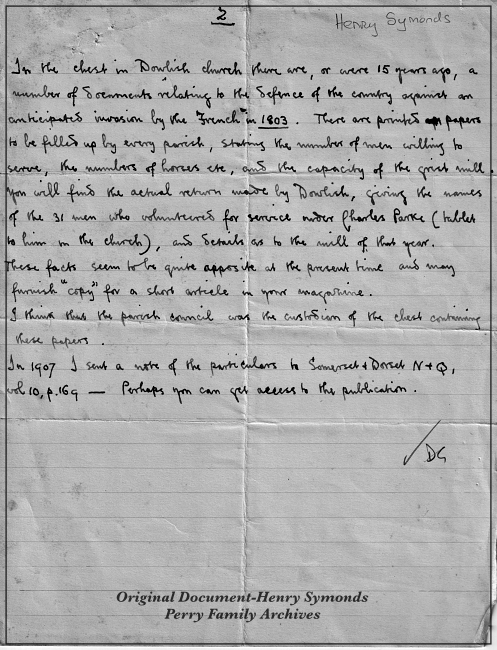
‘by an uncontrolled spring cleaning' in the church. This was conveyed to Henry Symonds in 1921 by the assistant overseer who, almost in tears, told of the destruction of old books, loose papers, apprentice bonds and the 'returns' from Dowlish regarding the 'defence of Somerset' in 1803.
Septimus Collinson, the rector from 1778 to 1827, the name of the assistant overseer, unknown.
Disaster averted
But all was not lost, thanks to Henry Symonds in 1903, who sought out and recorded some of the said contents of the parish chest. Indeed, in 1907, Henry Symonds published the details in the journal Notes and Queries for Somerset and Dorset. Volume 10 p16.
Henry's purpose in Dowlish Wake in both 1903 & 1921 was to assist in gathering geological data for the Symonds family of Dowlish Mill. This is explained online in a blog by a descendant of Ann Milbourne. Ann had married Edward Symonds, who became yeoman miller of Dowlish Wake. The miller previous to Edward was Anne's father, William Milbourne. Edward made alterations to the mill, installing a stone inscription tablet on the Mill frontage. Inscribed 1710 with the initials S. E. A. The blog can be found at; wasfu-man-symondspedigree.blogspot.com & wasfumansymondspedigreeupdate.blogspot.com .
Overall, the Crown were asking of their parishioners;
- Volunteered able-bodied men 15–60 years and how such armed.
- Provision of wagons, carts, horses etc.
- Miller’s capacity to aid supplies to the army from the parish grist mill. The Crown required the miller to provide in seamed cloth bags dry/sweet/clean flour, being of good 'marketable English wheat', the bran having been taken out.
- The name of a parish ‘worthy’ nominated to act as Lieutenant, to be involved with training, exercising and commanding such a body of men.
It was expected that those willing to serve would assemble in troops or companies under the person who had been chosen amongst themselves.
The men on foot, infantry would be expected to bear arms of pitchforks or firelocks, those on horse, swords or pistols. Otherwise, would be provided with arms at the allotted place of assembly.
Notes given to Lieutenants recommended men bring along a small bag for bullets, a bullet mould for their calibre of gun or pistol, and a powder horn. Delivery of lead and powder would be made at assembly.
Pay for the agricultural labourers volunteering would be at the going rate of hiring labourers throughout the country. Captains at 5 shilling per diem and other leaders of men at 3 shillings per diem.
Notes
Population of Dowlish
Dowlish Wake [East Dowlish] had a population of 241 in 1801. The ballot resulting in a reduced workforce for the many tasks and duties needed. Mouths to feed, crops to sow, harvests to gather in, threshing to organise. We know nothing of any trials and tribulations of wives, old folk, and the families of the 31 men left behind in Dowlish Wake.
Previously, some regimental wives had travelled with their men folk. However, in 1800, while the 1st Somerset Militia spent winter at Weymouth barracks, some wives had been involved in a riot in Weymouth town. Earl Poulett then banned them from travelling with the regimental baggage waggons and residing in the actual barracks.
The Patriotic Fund was founded in 1803 for those wounded in service to the Crown. In 1805, Samuel Alford, on behalf of Barrington and Dowlish Wake Churches, forwarded £2 6s 0d to the fund.
King George III and Weymouth.
For several years [1789-1805], in the summertime, King George brought his family to Weymouth; the Somerset regiments, too, would stay for the duration. His accommodation, Gloucester Lodge, is now a hotel.
Somerset Military
The West Somerset Yeomanry was first raised in 1794 to increase the Militia following another threat of invasion from the French. Up on Windwhistle Down, the moor served as an exercise ground for the Ilminster Troop of Cavalry.
Henry Symonds
We are indebted to Henry Symonds for this small glimpse of Dowlish Wake in 1803.
Born in 1859, his interests included local history, genealogy, an expert in reading old records., together with;
Barrister at Law called to the bar in 1886.
FSA [Fellow of the Society of Antiquaries]
The Royal Numismatic Society of London [in wartime volunteer assistant keeper, Dept of coins in the British Museum].
[he published many articles in the Numismatic Chronicle]
Proceedings of the Dorset Natural History and Antiquarian Field Club, [Editor]
Somersetshire Archaeological and Natural History Society, [Honorary Secretary]
Mrs Perry met and corresponded with Henry Symonds and saved in her archives a page of his investigations, the content of which began our research here. The 1920s, page written by Henry Symonds, thus survived and our tangible record of events in 1803.
Henry Symonds Died in 1933, aged 74. His funeral was at Dowlish Wake.
Lieutenant Charles Parke.
The War Office posted on 21 June 1803 new Commissions in the various regiments. Ensign Charles Parke was made Lieutenant of the 3rd Regiment of Foot by purchase. This method of purchasing a commissioned office in the British Army was commonplace.
Charles Parke [1751- 1828] lived in Parke House, Dowlish Wake, therefore a local regiment. As an aside, his wife Jane Parke, the provider of a chapel in Dowlish Wake for the many followers of the sect of Joanna Southcott, the Southcottians!
Parke House was demolished in the 1950s, its replacement ‘The Old Rectory’.
Samuel Gange/Genge
Samuel Gange, 1771-1853, appears to have been a dutiful member of the village community. In the old village poor rate book, what was then East Dowlish, over several years, his name and signature were prominent Church Warden and Overseer of the poor; he also traded as a blacksmith, wheelwright and carpenter. The year of the ballot, a family man, aged 32 years, appearing in St Andrews records the baptism of his new son George.
Sources:
Spring-cleaning disaster. Documents at one time were stored within the Parish Chest at Dowlish Wake. Henry Symonds's contribution in volume 10, 1906 of Somerset & Dorset Notes & Queries publication forms the basis of the happenings of 1803. He is replying to Query number 104 regarding 'Defence of Somerset against invasion 1803', writing of Dowlish Wake's response. It is Henry Symonds who tells us that sometime between 1903 and 1921, the Dowlish Wake 1803 'returns' were destroyed.
Henry Symonds arranged publication in 1906 of the 1803 details in The Notes & Queries journal, basic details, but not the names of the 31 men. Mention is made of the Dorset records in Volume 9 to illustrate the actual printed forms, apparently identical to those of Somerset. Dowlish Wake documents were destroyed sometime in 1920.
Notes and Queries for Somerset and Dorset. Volume 10. 1906. Pages 169 & 170. Queries Number 104. Volume 9. Pages 137,178,183,227,273,359. Defence of Dorset against invasion. Available at Taunton Archives and online at nq.oxfordjournals.org & sdnq.org.uk & findmypast.co.uk & ancestry.co.uk & thegenealogist.co.uk & other online subscription websites.
Book: A Memoir of the Family of Symonds in Somerset and Dorset. Author: Henry Symonds. 1933. Out of print. Online at; wasfu-man-symondspedigree.blogspot.com & wasfumansymondspedigreeupdate.blogspot.com .
Available at Somerset Library. On request, not on shelves.
Army Rates of Pay; ‘napoleon-series.org’ Rates of pay in the British Army in the 1800s
Bridgewater meeting. The Weekly London Dispatch. 17 July 1803.
See the Online subscription website, findmypast.co.uk – The British Newspaper Archive.
Open Air Meetings.
Bath & Bridgewater meetings. Text taken from Bath Chronicle and Weekly Gazette published 21 July 1803.
Sherbourne Mercury, 11 July 1803
Bridgewater meeting. The Weekly London Dispatch. 17 July 1803.
See the Online subscription website, findmypast.co.uk – The British Newspaper Archive.
Editorial column & dialogues; Advertisements in The Birmingham Post and London Gazette. July 1803
Advertiser; Knott & Lloyd, booksellers and Stationers.
In the same newspaper, the editorial columns had the heading: ‘Patriotic and Popular Publications. [So powerful an engine].
The Christian Observer, Vol 2: Literary and Philosophical Intelligence. Call to Arms- Vol 2;
& Aris’s Birmingham Gazette, 1st August 1803.
See the Online subscription website, findmypast.co.uk – The British Newspaper Archive.
Local Worthies: Collecting details of volunteers for military service were local worthies such as churchwardens, overseers of the poor and tythingmen [duties of the latter; attending Petty Sessions, acting as constable, collecting tythes].
The population of Dowlish Wake [East Dowlish] in 1801 & Edward Symonds see british-history.ac.uk
Population Weymouth. bexhilloldtown.org
Medieval Free Co. They attend shows displaying their recreated medieval living history camp. It is well worth seeking out at venues such as The Oak Fair at Stoke Gaylard in Dorset. See theoakfair.com and medievalfreeco.org.uk
Charles Parke commission by Purchase. To be Lieutenant, by purchase. See Kentish Weekly Post or Canterbury Journal. 19 July 1803. See the Online subscription website, findmypast.co.uk – The British Newspaper Archive. & Purchase of Commissions in British Army. en.m.wickipedia.org
Per- Diem. Latin phrase meaning 'per day', a set allowance for lodgings, meals, and incidental costs.
Somerset Militia. For background, see Wikipedia. French Revolutionary War & War of the Second Coalition 1792-1802 & France-United Kingdom relations. & Napoleon Bonaparte.
Somerset Military Museum, Taunton Castle.
King’s German Legion. Bexhilloldtown.org
Records of the Dorset Imperial Yeomanry, 1894-1905, edited by Captain M F Gage, 7th Dragoon Guards. A second volume is mentioned, covering the period of eleven years from 1894.
Songs and ballads:
Girl I Left Behind Me. Page 25 of Francis and Days No 2 Community Song Album. Dowlish Wake archives.
Britons To Arms. No 7891926 Printed in 1803. Publisher John Wallis
Britannia’s Charge to the Sons of Freedom. No 74896642. Printed in 1803. Author Nicholas Rowe.
English ballads;
Digital Gallery- National Library of Scotland- Wars – Napoleonic Wars [1803-1815]
Image CC-BY-NC-SA Creative Commons Attribution-NonCommercial-ShareAlike 4.0 International Licence
20,000 men enrolled. See Bridgwater-tc.gov.uk
List of Volunteers Somerset
East Somerset Yeomanry ;
Earl Poulett – [established 6 August 1802].
Colonel of the 1st Somerset Militia 1798
Colonel of the East Somerset Regiment of Yeomanry Cavalry in 1803
Crewkerne – William Gray – 20 August 1803.
West Somerset West Yeomary – Lord Dorchester – 12 February 1803
en.everybodywiki.com
Militia Insurance Advertisements, both Crutwells & Keeles, appeared in the Salisbury and Winchester Journal, 3rd May 1802. Online subscription website: findmypast.co.uk – The British Newspaper Archive.
Summer Encampments. 7 July 1805.Bells Weekly Messenger. & Hampshire Chronicle. See the Online subscription website, findmypast.co.uk – The British Newspaper Archive.
1st Somerset Militia. Wives Rioting- Weymouth. See eb.m.wikiedia.org W.J.K. Kerr page 40-43 Records of 1st Somerset Militia.
Marching. Portsmouth/Southampton/Weymouth. Printed 1st & 8th & 15th July 1805, Hampshire Chronicle.
1805 Weymouth to Sussex Barracks November 1805. The Globe, London 28 November 1805
Online subscription website: findmypast.co.uk – The British Newspaper Archive.
His Majesty King George 111, visit to Weymouth. London Evening Mail, 1 October 1804
Online subscription website: findmypast.co.uk – The British Newspaper Archive.
The King took up residence in 1804 at what is now known as Gloucester House, Weymouth seafront.
Various online resources. See blog by Rachel Knowles; regencyhistory.net
The Patriotic Fund. Barrington and Dowlish Wake. St James Chronicle, London. 28 December 1805.
Samples of Substitution and Ballot papers 1926 - National Army Museum - collection.nam.ac.uk - CC-BY-NC-DN & NAM 1987 11-117-2
Image of Soldiers - records of the 1st Somerset Militia 1812 - 1816 - online at Wikipedia Foundation
Work by Captain Herbert Oakes-Jones -Aldershot - Gale & Polden
Samuel Gange Signature - Dowlish Wake Vestry Book - Dowlish Wake Heritage Files & Perry Family Archives.
